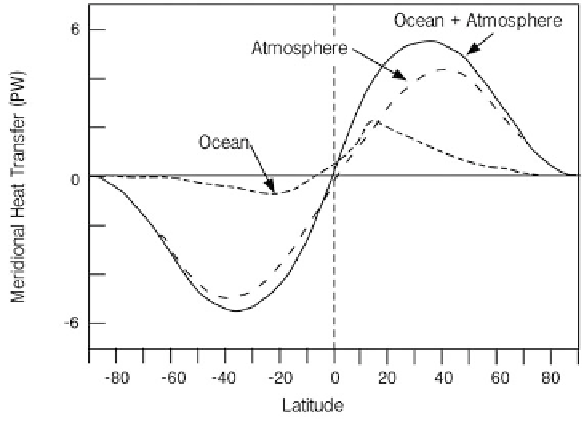Geoscience Reference
In-Depth Information
Figure 8.5. Total meridional heat flux of the combined ocean-atmosphere system estimated
from Earth Radiation Budget Experiment (ERBE) satellites, direct ocean measurements, and
atmospheric contribution as a residual (1 PW
¼
10
15
watts) (Wunsch, 2005, 2006).
(extending to shutdown) of the North Atlantic MOC and perhaps even failure of
the Gulf Stream. Wunsch emphasized that generally one must distinguish between
climate phenomena whose (a) trigger regions, (b) foci of strongest signal, and (c)
regions where a signal is detectable may each be radically different. Regarding the
trigger, he presented
Figure 8.5
showing the contributions made by the atmo-
sphere and the oceans to meridional heat flux toward the poles. Contrary to
widely held perceptions, the oceans only deliver a modest fraction of the heat flux
to high northern latitudes and heat transport by the atmosphere outweighs that by
the oceans 7:1 at the 50
N latitude.
The assumption that the prime mover of abrupt climate change is fractional
change in the comparatively minor contribution of ocean currents to global heat
flux may not hold up under this scrutiny. Wunsch (2006) discussed how atmo-
spheric heat transport might be affected if there were a shutdown of the oceanic
heat flux and suggested that it could produce ''a warmer (and/or wetter) Northern
Hemisphere atmosphere rather than a colder one.'' The disparity between oceanic
and atmospheric poleward heat fluxes is enough to raise doubts that the MOC is
the major source of abrupt climate change. But Wunsch amplified this argument
by questioning how such overturning might occur. Inevitably, the theory requires
an injection of fresh water, probably from a strong decrease in surface salinity
from melting glacial ice. Wunsch provided several reasons to doubt this hypothesis
and finally suggested that the most effective way to change ocean circulation is via
a change in wind fields.
On the other hand, as Wunsch (2005) said:

Search WWH ::

Custom Search